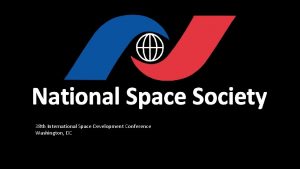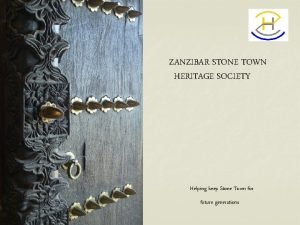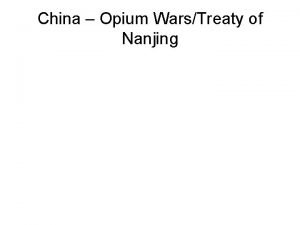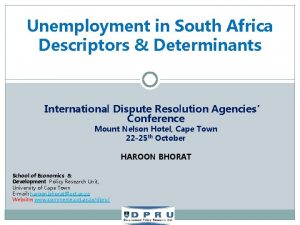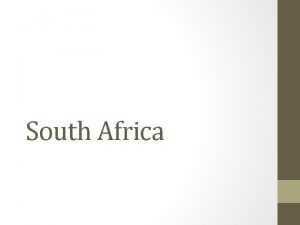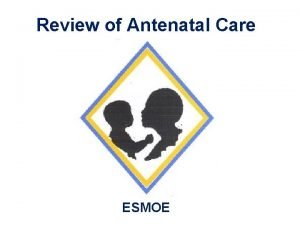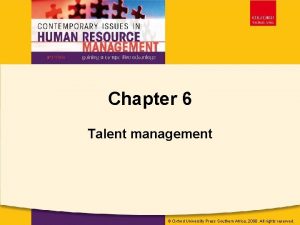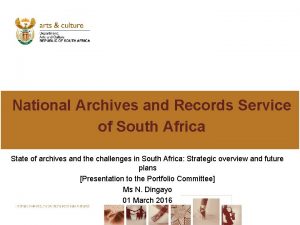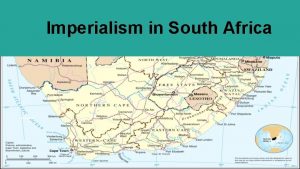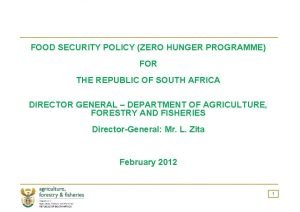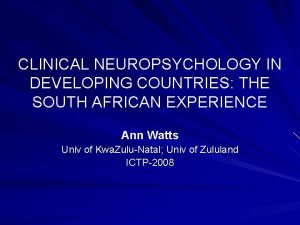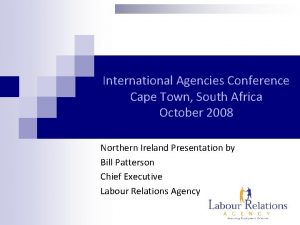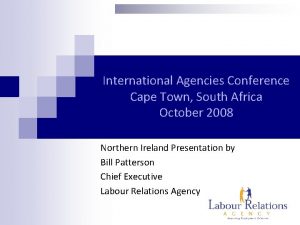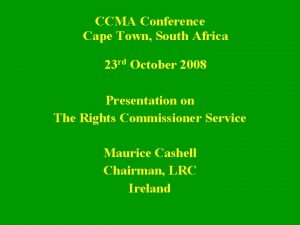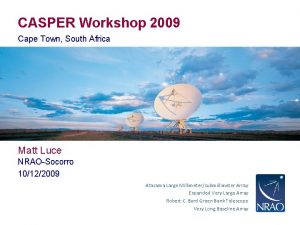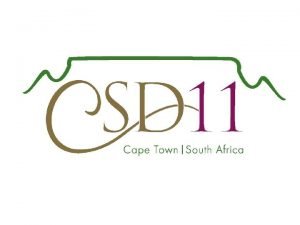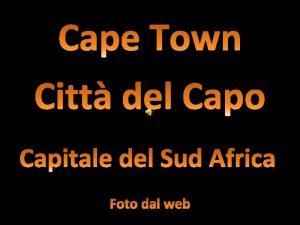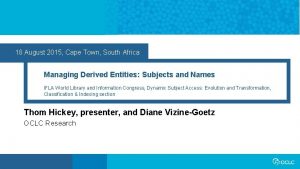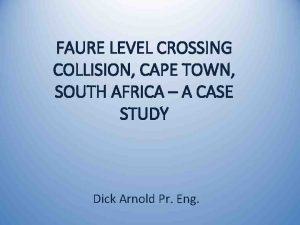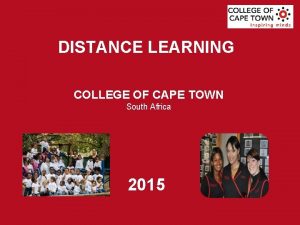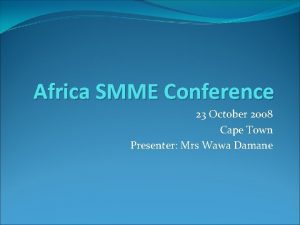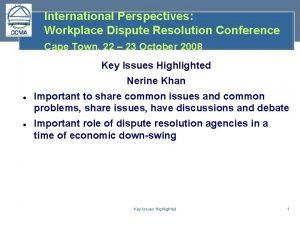International Career Development Conference Cape Town South Africa































- Slides: 31

International Career Development Conference, Cape Town, South Africa, 19 – 21, October, 2011 CAREER DESIGNING IN LITHUANIA: STATE OF ART & CHALLENGES Kestutis Pukelis Nora Pileicikiene Vytautas Magnus University Centre for Quality of Studies

Issues to be covered Short information about Republic of Lithuania Short history of career designing in Lithuania Development of career designing in Lithuania Why career designing? Main challenges for further development of career designing

Lithuania: capital Vilnius

Lithuania in numbers • Population: 3. 053. 800 • Population growth rate: -0. 33% • Ethnic groups: Lithuanian 83. 9%, Russian 5. 4%, Polish 6. 6%, Belarusian 1. 3%, other 2. 8% • Religion: Roman Catholic (primar. ) • Official language: Lithuanian • Literacy : 99. 6% Population (25 -65 years) distribution according to education level: 31 % - higher, 60 % - (vocational) secondary, 9 % - lower.

46 000 – students of higher education 40 500 – students of secondary education Kaunas: second largest city

9 faculties & 1 academy: Faculty of Art, Faculty of Catholic Theology, Faculty of Economics and Management, Faculty of Humanities, Faculty of Informatics, Faculty of Law, Faculty of Natural Sciences, Faculty of Political Science and Diplomacy, Faculty of Social Science, Music Academy Number of students: 9700 Number of teachers: 550

Short history Republic of Lithuania: 1918 -1940 Development of national education system; Soviet period: 1940 -1990 Vocational orientation in soviet education system; Reestablishment of Republic of Lithuania: 1990 -1995 – period of “silence” for career designing 1995 - up to date – introduction and development of career designing

Career designing as part of lifelong learning n Introduction of career designing in Lithuania after 1995: n a) support in decision making on the choice of profession (career education) b) support for further career development n

Development of career designing system in Lithuania: first stage 2001 -2003 Development of Career designing strategy in Lithuania 2006– 2008 National project supported by EU Structural Funds, targeted on introduction of career education in general education and VET systems

Project results 3 standards were designed: Vocational information standard, Occupational standard of vocational counsellor, Occupational training standard of Vocational counsellor n Appr. 2200 Vocational advisers, teachers, social workers, psychologists were trained. n n n 310 out of 690 vocational information centres were accredited. n 6 learning programmes 10 methodological guidelines

Vocational information Centers n n Number: 690 Function: provide vocational information for students and help them to make a right choice of study path. Spread: in every municipality Location: secondary schools, gymnasiums, vocational schools, educational centres, municipalities, libraries, etc.

Project results n All project results were summarized in Vocational information and counseling handbook (3 volumes)

Development of career designing system in Lithuania: second stage 2010 -2013 National project supported by EU Structural Funds, targeted on introduction of further career development in higher education system 12 Universities and 15 colleges involved n Aim of the project – to develop accessible and responding to students needs model of career management service (career education, career counselling, career information, career assessment and monitoring of graduates career).

Expected project results n n n Designed description of model for career management service 8 compendiums of means for career management of higher education students developed 263 specialists trained to provide career management services for HE institutions students.

Expected project results n n For 3000 students pilot career education service provided Designed and introduced virtual national system of career management service based on ICT

Career counsellors’ professional development Types of study programmes n n n Continuous studies Continuous inconsecutive studies Study programmes within projects

Continuous studies Master study programme Career Designing (at four universities) The aim is to develop research skills of career designing phenomenon to be able to collect and process information that meets the needs of career counselling target groups, to ensure its availability, to provide it and give advice to each individual or a group of individuals when creating conditions to make rational decisions related to the choice of a profession or further career development, coordinating individual goals of personality development and self expression with the constantly changing labour market needs

Continuous inconsecutive studies Module based learning Module – 2 (3 ECTS) credits, 80 hours Target groups: educators of vocational institutions and secondary schools, labour market specialists, labour exchange counsellors and personnel managers

Continuous inconsecutive studies Modular programmes for career counsellors (since 2002) Participants: n Career counsellors from labour exchanges n Mediators from labour exchanges n Business counsellors from labour exchanges n Career counsellors from labour market training authorities

European structural fund project Development and Implementation of the Master Study Programme "Career Counselling" Aim of the project: To develop master study programme for career counsellors working in education and labour market institutions and in such a way to contribute to the researches, evaluation and quality of human resource management.

Main objectives of the project 1. To carry out a research on career counsellor’s functions and qualification in European countries and abroad. 2. To develop and legalize the second stage master study modular programme “Career Counselling”. 3. To develop teaching-learning material - toolkits for study modules.

Why career designing? What kind Philosophy of Education is? The human being is like a bird: one wing is a job he/she likes, another one – person he/she loves.

What kind Philosophy of Career Designing is? Premises n Career designing: strategic method and mean for human resource management n Vocation (calling) – keystone of professional choice n No incapable people: the only one question is what kind of calling she/he possess? n Substantial criterion of vocation – inborn form of intellect (special aptitude) n The form of intellect (special aptitude) could be recognized

What are the Main Principles of Career Designing? Principles: n In every human being already exist idea of prospective profession (Aristotle) n The law of matching of ideas n The law of potential (aptitude) and actual (skills) n Vocation is inborn and could be developed n The choice of profession must be based on (self)selection

Career Designing Is ability to envisage prospective tendencies of the labour market change and in the context of anticipated alterations to research, plan and implement the processes of one’s professional development in line with own meaning of the life, striving maximally to materialize inborn aptitudes to compete successfully in the permanently changing labour market

Why career designing? n The semantic analysis of the concept “guidance” asserts that in today’s philosophy of a rational vocational choice and further career development a words combination “career guidance” does not reflect original meaning of phenomenon which this concept represents, i. e. it contradicts to its semantics.

Why career designing? n n The contemporary philosophy of rational vocational choice and further career development supports the holistic attitude to a person putting the individual aptitudes and vocation (calling) to the first place; Holistic approach claims that there are no incapable people;

Why career designing? n n n “Career designing” semantically is more precise reflection of a phenomenon hidden under nowadays “career guidance”; The term “designing” comes from “designer”, term used in fashion; Career designing reflects philosophy where counselling of person is based not on labor market needs, but on the inborn qualities of the person. This is the claim of the knowledge society;

n n n Career designing philosophy stresses constructivist and holistic approach where labor market is understood as a product of the human being creativity which stems from inborn qualities, not otherwise; The outcome of career designing is a career design of a person; Career designing is a lifelong continuing process;

Main challenges for future development of Career designing n n To enhance: Accessibility for career designing and counseling service; Quality of career designing and counseling service; To bring together efforts of teachers, their students, professionals, employers, politicians and parents making more coordinated career designing and counseling services

Thank you for your attention k. pukelis@smf. vdu. lt n. pileicikiene@skc. vdu. lt
 Sin values
Sin values Exhibition stands south africa
Exhibition stands south africa Chakra lines earth
Chakra lines earth Rovos rail cape town to dar es salaam
Rovos rail cape town to dar es salaam Milkor cape town
Milkor cape town Agriprotien
Agriprotien Elim - cape south coast
Elim - cape south coast What is the history of community development in tanzania?
What is the history of community development in tanzania? Human resource development council of south africa
Human resource development council of south africa International space development conference
International space development conference In on at practice
In on at practice Zanzibar stone town heritage society
Zanzibar stone town heritage society Imperialism in africa berlin conference
Imperialism in africa berlin conference Great leap forward communes
Great leap forward communes Agrement south africa
Agrement south africa Herbalife millionaire team salary in south africa
Herbalife millionaire team salary in south africa Causes of unemployment in south africa
Causes of unemployment in south africa Dr hamilton south africa
Dr hamilton south africa Unjust enrichment latin
Unjust enrichment latin Political map of north africa and southwest asia
Political map of north africa and southwest asia 11 official languages of south africa
11 official languages of south africa Musket
Musket How many capital cities in south africa
How many capital cities in south africa Antenatal assessment format
Antenatal assessment format Oxford university press south africa
Oxford university press south africa 6 ministerial priorities of health
6 ministerial priorities of health South african national archives
South african national archives Safbc
Safbc African imperialism timeline
African imperialism timeline Zero hunger programme south africa
Zero hunger programme south africa Africa south of the sahara map
Africa south of the sahara map Neuropsychology in south africa
Neuropsychology in south africa









